WPF 数据绑定 使用Code First with Database
一、准备工作
1.开发工具 Visual Studio 2013
2.安装 Entity Framework 6 Tools for Visual Studio 2012 & 2013 来实现 Code First with Database
工具下载: http://www.microsoft.com/en-us/download/details.aspx?id=40762
3.创建示例数据库 MyShop

USE MyShop GO CREATE TABLE [dbo].[Categories] ( [CategoryId] [INT] NOT NULL IDENTITY , [Name] [NVARCHAR](MAX) , CONSTRAINT [PK_dbo.Categories] PRIMARY KEY ( [CategoryId] ) ) CREATE TABLE [dbo].[Products] ( [ProductId] [INT] NOT NULL IDENTITY , [Name] [NVARCHAR](MAX) , [CategoryId] [INT] NOT NULL , CONSTRAINT [PK_dbo.Products] PRIMARY KEY ( [ProductId] ) ) CREATE INDEX [IX_CategoryId] ON [dbo].[Products]([CategoryId]) ALTER TABLE [dbo].[Products] ADD CONSTRAINT [FK_dbo.Products_dbo.Categories_CategoryId] FOREIGN KEY ([CategoryId]) REFERENCES [dbo].[Categories] ([CategoryId]) ON DELETE CASCADE GO INSERT INTO dbo.Categories ( Name ) VALUES( N'水果' ) INSERT INTO dbo.Categories ( Name ) VALUES( N'肉类' ) GO INSERT INTO dbo.Products ( Name, CategoryId ) VALUES ( N'苹果', 1) INSERT INTO dbo.Products ( Name, CategoryId ) VALUES ( N'菠萝', 1) INSERT INTO dbo.Products ( Name, CategoryId ) VALUES ( N'猪肉', 2) INSERT INTO dbo.Products ( Name, CategoryId ) VALUES ( N'牛肉', 2) INSERT INTO dbo.Products ( Name, CategoryId ) VALUES ( N'人肉', 2) GO

二、创建项目 WPFwithEFSample
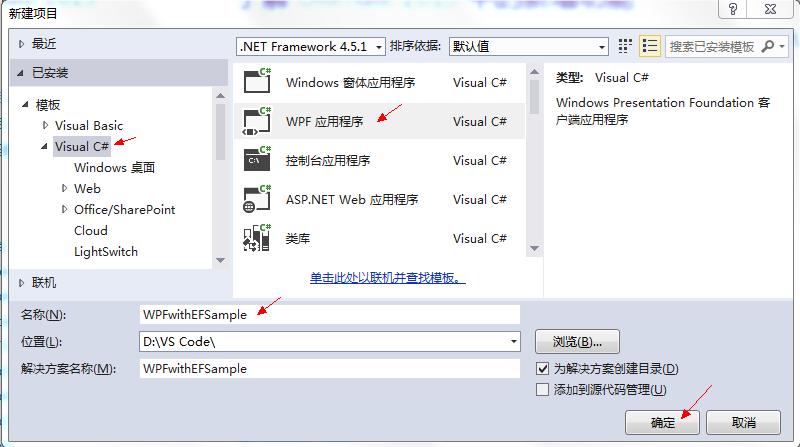
三、更新 Entity Framework
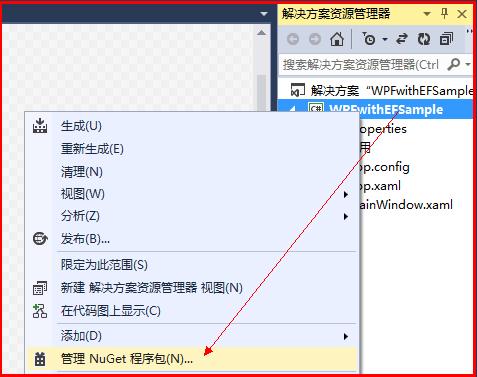
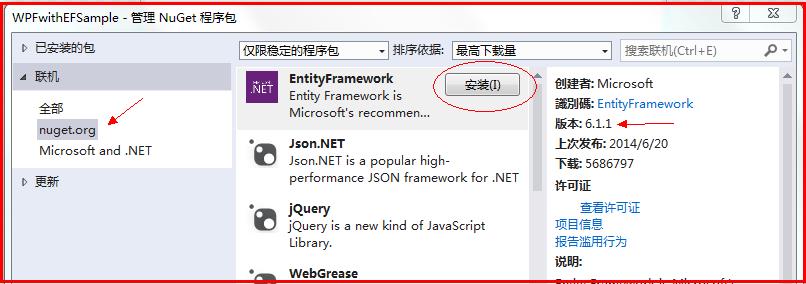
四、创建Code First with Database
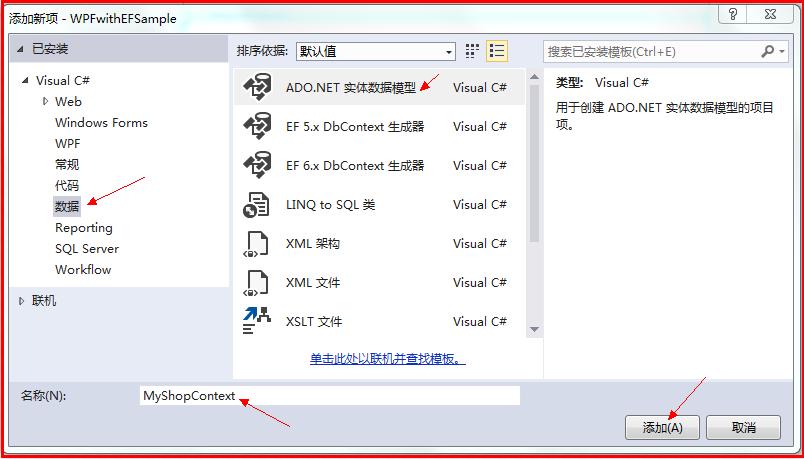
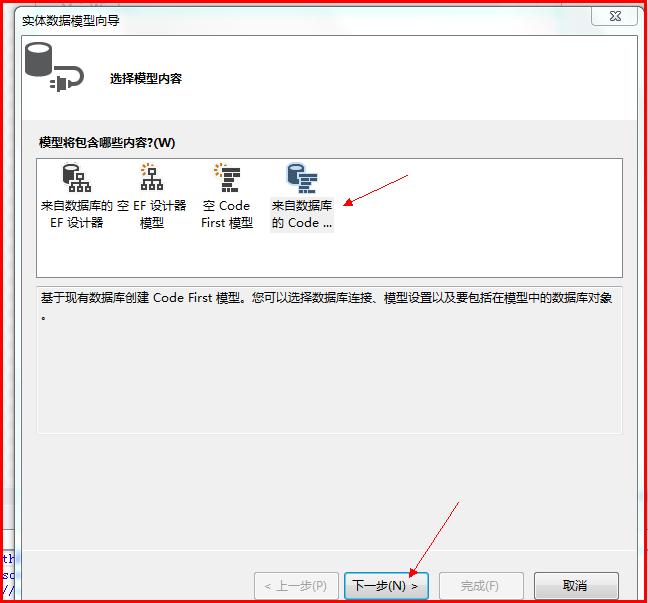

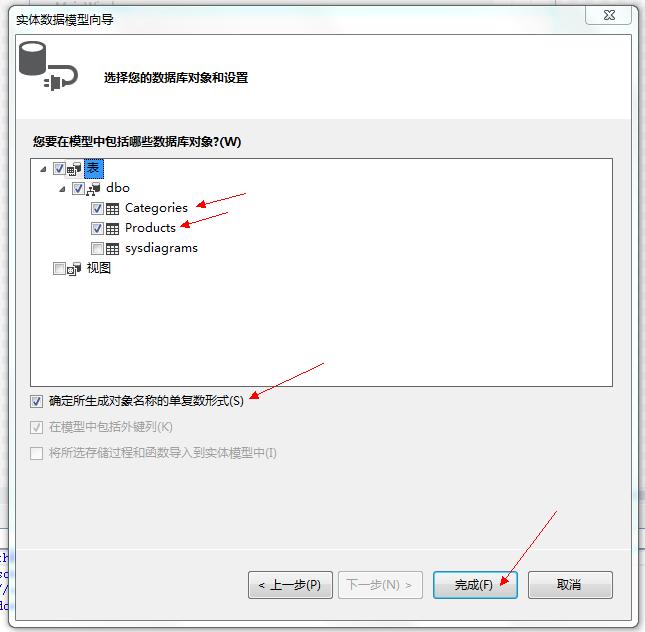
上面的步骤会自动生成实体类,所以需要编译一下,下一步的动作才会显示出需要的对象。
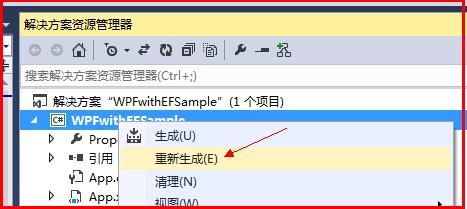
我们看下Code First with Database 工具帮我们生成了什么东东。
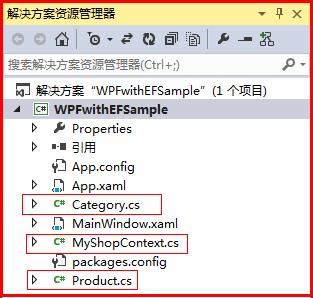
生成了3个文件,其中2个实体文件,分别对应数据库里的2张表Category 和 Product。还有一个MyShopContext.cs,这是数据库上下文,操作数据库的时候需要实例化此类。

namespace WPFwithEFSample { using System; using System.Collections.Generic; using System.ComponentModel.DataAnnotations; using System.ComponentModel.DataAnnotations.Schema; using System.Data.Entity.Spatial; public partial class Category { public Category() { Products = new HashSet<Product>(); } public int CategoryId { get; set; } public string Name { get; set; } public virtual ICollection<Product> Products { get; set; } } }

namespace WPFwithEFSample { using System; using System.Collections.Generic; using System.ComponentModel.DataAnnotations; using System.ComponentModel.DataAnnotations.Schema; using System.Data.Entity.Spatial; public partial class Product { public int ProductId { get; set; } public string Name { get; set; } public int CategoryId { get; set; } public virtual Category Category { get; set; } } }

namespace WPFwithEFSample { using System; using System.Data.Entity; using System.ComponentModel.DataAnnotations.Schema; using System.Linq; public partial class MyShopContext : DbContext { public MyShopContext() : base("name=MyShopContext") { } public virtual DbSet<Category> Categories { get; set; } public virtual DbSet<Product> Products { get; set; } protected override void OnModelCreating(DbModelBuilder modelBuilder) { } } }
MyShopContext.cs 代码中的 name=MyShopContext 值来自于配置文件 App.Config中的数据库连接字符串

<connectionStrings> <add name="MyShopContext" connectionString="data source=.;initial catalog=MyShop;user id=sa;password=*******;MultipleActiveResultSets=True;App=EntityFramework" providerName="System.Data.SqlClient" /> </connectionStrings>
五、添加数据源,来自对象,也就是刚才用Code First with Database 工具生成的类,并且需要编译一次,否则向导工具发现不了!
调出数据源窗口:视图 -> 其他窗口 -> 数据源
然后点击 数据库窗口的超链接“添加数据源...”
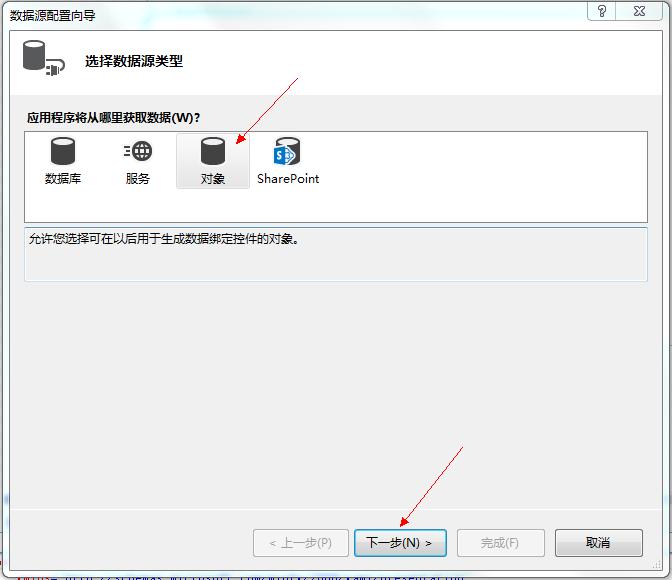
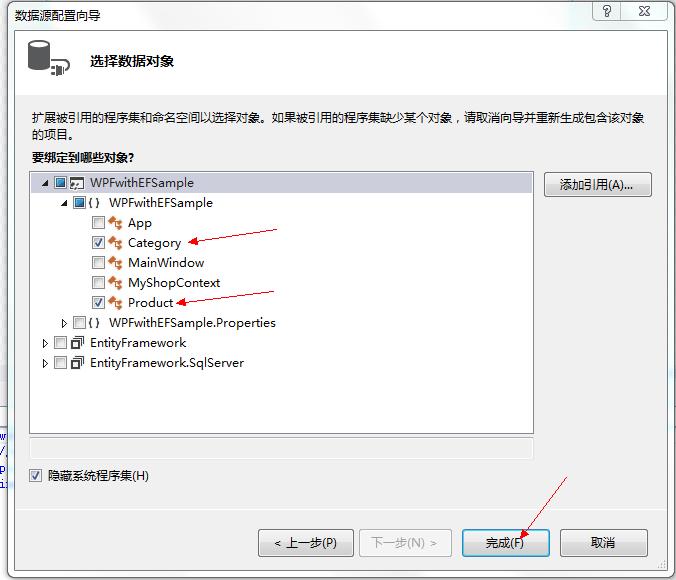
如果没发现Category 和Product 选项,重新编译一下就可以了。
点击完成后,在数据源窗口会出现相关项:

生成的这些项后,我们就可以用鼠标拖到窗口后,就能创建界面控件
如果把Category用鼠标拖到界面就能创建GridView控件等
接下来我们就点击上面第一个Category项直接拖入到 MainWindow.xaml 图形界面,看看会产生什么。(不知道为什么每次都要拖2次才成功,可能是VS2013的bug吧)
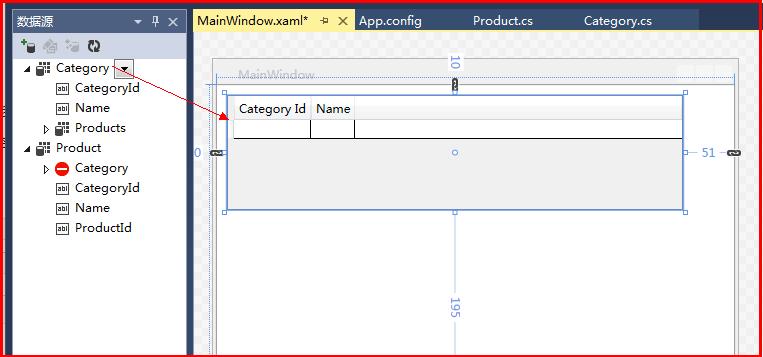
拖入完后,会在2处自动添加代码,一个是 MainWindow.xaml , 另一个是 MainWindow.xaml.cs

<Window xmlns="http://schemas.microsoft.com/winfx/2006/xaml/presentation" xmlns:x="http://schemas.microsoft.com/winfx/2006/xaml" xmlns:d="http://schemas.microsoft.com/expression/blend/2008" xmlns:mc="http://schemas.openxmlformats.org/markup-compatibility/2006" xmlns:local="clr-namespace:WPFwithEFSample" mc:Ignorable="d" x:Class="WPFwithEFSample.MainWindow" Title="MainWindow" Height="350" Width="525" Loaded="Window_Loaded"> <Window.Resources> <CollectionViewSource x:Key="categoryViewSource" d:DesignSource="{d:DesignInstance {x:Type local:Category}, CreateList=True}"/> </Window.Resources> <Grid DataContext="{StaticResource categoryViewSource}"> <DataGrid x:Name="categoryDataGrid" RowDetailsVisibilityMode="VisibleWhenSelected" Margin="10,10,51,195" ItemsSource="{Binding}" EnableRowVirtualization="True" AutoGenerateColumns="False"> <DataGrid.Columns> <DataGridTextColumn x:Name="categoryIdColumn" Width="SizeToHeader" Header="Category Id" Binding="{Binding CategoryId}"/> <DataGridTextColumn x:Name="nameColumn" Width="SizeToHeader" Header="Name" Binding="{Binding Name}"/> </DataGrid.Columns> </DataGrid> </Grid> </Window>

using System.Text; using System.Threading.Tasks; using System.Windows; using System.Windows.Controls; using System.Windows.Data; using System.Windows.Documents; using System.Windows.Input; using System.Windows.Media; using System.Windows.Media.Imaging; using System.Windows.Navigation; using System.Windows.Shapes; namespace WPFwithEFSample { /// <summary> /// MainWindow.xaml 的交互逻辑 /// </summary> public partial class MainWindow : Window { public MainWindow() { InitializeComponent(); } private void Window_Loaded(object sender, RoutedEventArgs e) { System.Windows.Data.CollectionViewSource categoryViewSource = ((System.Windows.Data.CollectionViewSource)(this.FindResource("categoryViewSource"))); // 通过设置 CollectionViewSource.Source 属性加载数据: // categoryViewSource.Source = [一般数据源] } } }
接下来我们要分析一下这些自动生成的代码的用意。先看 MainWindow.xaml.cs,它就一条语句,意思是:在MainWindow.xaml 页面找到名为"categoryViewSource" 控件,并把他转换为CollectionViewSource类型。
private void Window_Loaded(object sender, RoutedEventArgs e) { System.Windows.Data.CollectionViewSource categoryViewSource = ((System.Windows.Data.CollectionViewSource)(this.FindResource("categoryViewSource"))); // 通过设置 CollectionViewSource.Source 属性加载数据: // categoryViewSource.Source = [一般数据源] }
来看下 MainWindow.xaml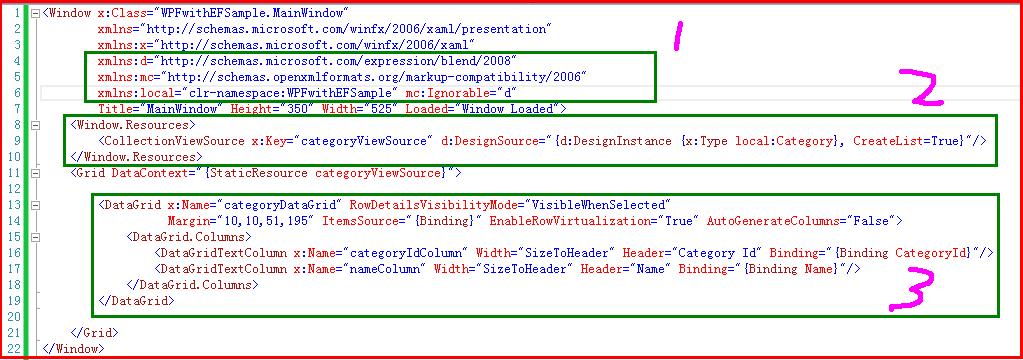
共自动生成了3大块代码,和其他的一些属性
明天继续。。。
第一段不知道怎么解释,搜了好多资料都没搜到,大概意思就是定义设计器里的名称空间d.......
第二段在窗体级别中定义资源,资源的内容为数据视图,它是数据源和请求数据源之前的接口,如图:

在CollectionViewSource 这里可以对请求的数据“把把关”(添加条件),做排序等。
最重要的是这个扩展属性 x:Key="categoryViewSource" 。对于窗体上的控件来说,它就是数据源。对于后台代码来说,需要把真正的后台数据交给它。
第三段就没什么好讲的了,就是DataGrid控件的具体细节,不过要注意的是它外层的Grid布局空间的一个属性DataContext="{StaticResource categoryViewSource}"
这个属性把上下文内容定义到这个控件的级别,那么他的子空间都可以共享其数据了。
六、添加管理子表的DataGrid 控件,达到的效果是,当电子表里的记录时,子表里的内容会根据附表中的类别号来检索产品。
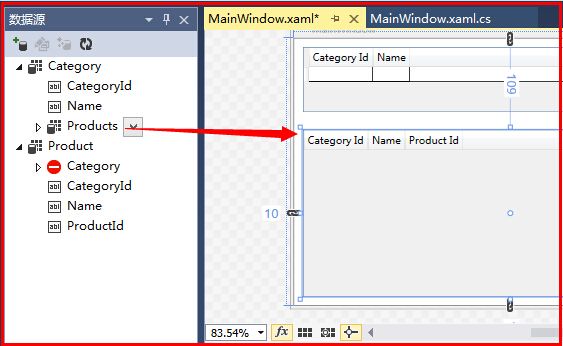
我们来看一下代码发生了什么变化,绿色框起来的为新增的,变化的文件只有一个 MainWindow.xaml
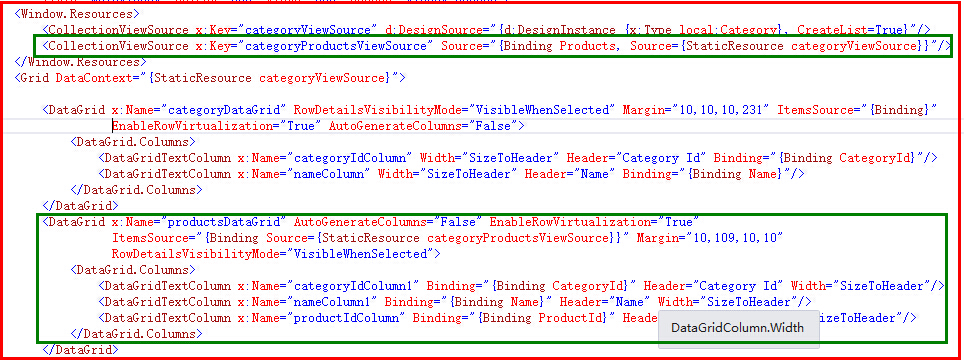
第一段绿色框起来的也是定义了一个“视图” ,它的数据类型为Products ,但数据源却是来自于上面那个视图的,也就是父视图
好了,到这里为止基本前台的界面都完成了,下面我们要在后台代码来检索数据,然后付给那个父视图控件。
System.Windows.Data.CollectionViewSource categoryViewSource = ((System.Windows.Data.CollectionViewSource)(this.FindResource("categoryViewSource")));
上面的代码是在我们拖入第一个DataGrid的时候自动创建的,意思是,在资源里找到一个名为categoryViewSource的资源对象,并转化为CollectionViewSource类型,
这样我们就能在后台代码里操作这个对象了。
首先在主窗体类的内部的最上面实例化我们的上下文类,可以把对象 _context看着是一个数据库。

然后再添加加载数据的代码

按F5运行程序,如下,在父表点击不同的记录,在子表里或自动变化。

接下来为程序做点加工,这些也都是在软件中经常要用到的功能。
1、为DataGrid 控件添加行编号,这样就能一眼看出记录数和快速定位行了。
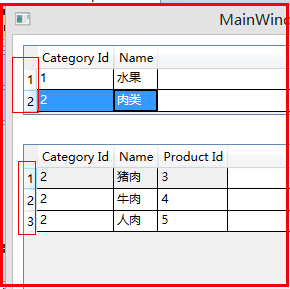
实现很简单,只要添加一个DataGrid 的 LoadingRow 事件即可。添加方法:选择DataGrid控件,然后再在属性窗口的事件标签项里找到 LoadingRow,在输入框中双击,就会跳转到实现代码,然后加入下列代码即可。
private void categoryDataGrid_LoadingRow(object sender, DataGridRowEventArgs e) { e.Row.Header = e.Row.GetIndex() + 1; }
下面还要添加几个按钮,来做数据的增删改查(CURD)
为了再在页面条件其他控件,我们必须用布局控件来规划窗体的布局。布局后的全部代码为:

<Window x:Class="WPFwithEFSample.MainWindow" xmlns="http://schemas.microsoft.com/winfx/2006/xaml/presentation" xmlns:x="http://schemas.microsoft.com/winfx/2006/xaml" xmlns:d="http://schemas.microsoft.com/expression/blend/2008" xmlns:mc="http://schemas.openxmlformats.org/markup-compatibility/2006" xmlns:local="clr-namespace:WPFwithEFSample" mc:Ignorable="d" Title="MainWindow" Loaded="Window_Loaded"> <Window.Resources> <CollectionViewSource x:Key="categoryViewSource" d:DesignSource="{d:DesignInstance {x:Type local:Category}, CreateList=True}"/> <CollectionViewSource x:Key="categoryProductsViewSource" Source="{Binding Products, Source={StaticResource categoryViewSource}}"/> </Window.Resources> <Grid DataContext="{StaticResource categoryViewSource}" Margin="5"> <Grid.RowDefinitions> <RowDefinition Height="*"/> <RowDefinition Height="*"/> </Grid.RowDefinitions> <StackPanel Grid.Row="0" Grid.Column="0"> <WrapPanel Orientation="Horizontal"> <Button x:Name="btnAddCategory" Content="Add..." Margin="5,5,0,5" Padding="8,5,8,5" /> <Button x:Name="btnDeleteCategory" Content="Delete..." Margin="5,5,0,5" Padding="8,5,8,5" /> <Button x:Name="btnUpdateCategory" Content="Upate..." Margin="5,5,0,5" Padding="8,5,8,5" /> <Button x:Name="btnSeachCategory" Content="Seach" Margin="5,5,0,5" Padding="8,5,8,5" /> </WrapPanel> <DataGrid x:Name="categoryDataGrid" RowDetailsVisibilityMode="VisibleWhenSelected" ItemsSource="{Binding}" EnableRowVirtualization="True" AutoGenerateColumns="False" LoadingRow="categoryDataGrid_LoadingRow" CanUserDeleteRows="False" CanUserAddRows="False"> <DataGrid.Columns> <DataGridTextColumn x:Name="categoryIdColumn" Width="SizeToHeader" Header="Category Id" Binding="{Binding CategoryId}"/> <DataGridTextColumn x:Name="nameColumn" Width="SizeToHeader" Header="Name" Binding="{Binding Name}"/> </DataGrid.Columns> </DataGrid> </StackPanel> <StackPanel Grid.Row="1" Grid.Column="0"> <WrapPanel Orientation="Horizontal"> <Button x:Name="btnAddProduct" Content="Add..." Margin="5,5,0,5" Padding="8,5,8,5" /> <Button x:Name="btnDeleteProduct" Content="Delete..." Margin="5,5,0,5" Padding="8,5,8,5" /> <Button x:Name="btnUpdateProduct" Content="Upate..." Margin="5,5,0,5" Padding="8,5,8,5" /> <Button x:Name="btnSeachProduct" Content="Seach" Margin="5,5,0,5" Padding="8,5,8,5" /> </WrapPanel> <DataGrid x:Name="productsDataGrid" AutoGenerateColumns="False" EnableRowVirtualization="True" ItemsSource="{Binding Source={StaticResource categoryProductsViewSource}}" RowDetailsVisibilityMode="VisibleWhenSelected" LoadingRow="productsDataGrid_LoadingRow"> <DataGrid.Columns> <DataGridTextColumn x:Name="categoryIdColumn1" Binding="{Binding CategoryId}" Header="Category Id" Width="SizeToHeader"/> <DataGridTextColumn x:Name="nameColumn1" Binding="{Binding Name}" Header="Name" Width="SizeToHeader"/> <DataGridTextColumn x:Name="productIdColumn" Binding="{Binding ProductId}" Header="Product Id" Width="SizeToHeader"/> </DataGrid.Columns> </DataGrid> </StackPanel> </Grid> </Window>
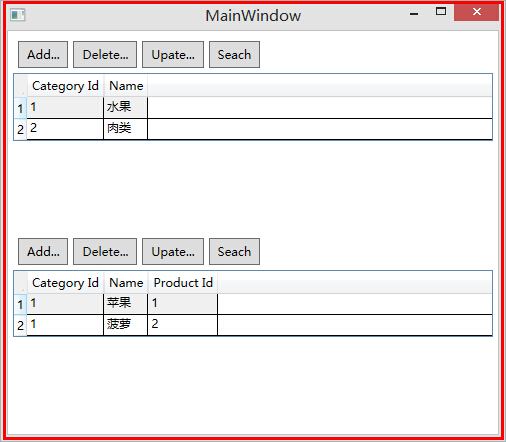
这样看起来还不错!
2个DataGrid还有一个小问题,就是选择一行后,其后有个很长的空白行,看起来很不爽,处理办法是吧最后一列的宽度该为* ,如:








【推荐】国内首个AI IDE,深度理解中文开发场景,立即下载体验Trae
【推荐】编程新体验,更懂你的AI,立即体验豆包MarsCode编程助手
【推荐】抖音旗下AI助手豆包,你的智能百科全书,全免费不限次数
【推荐】轻量又高性能的 SSH 工具 IShell:AI 加持,快人一步
· AI与.NET技术实操系列:基于图像分类模型对图像进行分类
· go语言实现终端里的倒计时
· 如何编写易于单元测试的代码
· 10年+ .NET Coder 心语,封装的思维:从隐藏、稳定开始理解其本质意义
· .NET Core 中如何实现缓存的预热?
· 分享一个免费、快速、无限量使用的满血 DeepSeek R1 模型,支持深度思考和联网搜索!
· 基于 Docker 搭建 FRP 内网穿透开源项目(很简单哒)
· ollama系列01:轻松3步本地部署deepseek,普通电脑可用
· 25岁的心里话
· 按钮权限的设计及实现